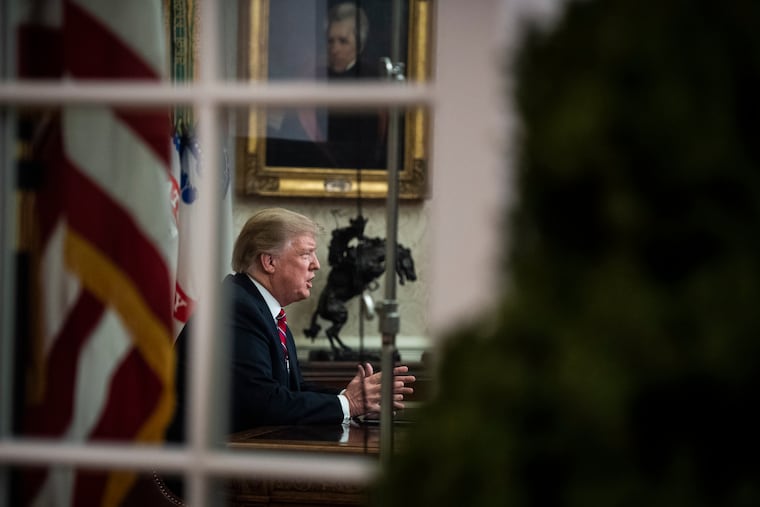How heroin and fentanyl get into Philadelphia — and why a border wall likely wouldn’t stop them
President Trump didn't mention on Tuesday that most of the country's heroin supply would get here with or without a wall. Traffickers usually smuggle drugs through legal crossing points at the southern border that already are patrolled.

In his prime-time address Tuesday night on shutting down much of the government over funding for a wall on the southern border, President Donald Trump suggested that the structure could help stop heroin from entering the country. “Every week 300 of our citizens are killed by heroin alone, 90 percent of which floods across our southern border,” he said.
But he didn’t mention his own Drug Enforcement Administration’s conclusion that traffickers smuggle most of the heroin through legal crossing points that are patrolled, not at unguarded stretches of the border.
So how does that heroin get into the U.S. generally, and the Philadelphia region specifically? Here are some answers, drawn from Inquirer reporting and recent DEA reports. (Local DEA representatives could not comment for this article Wednesday, because as part of the government shutdown, they may speak to reporters only about national security issues.)
How does heroin get to Philadelphia?
Heroin that lands here via Mexican drug-trafficking organizations is largely sent through legal entry points, according to a 2017 DEA report on the country’s drug supply. Drugs are hidden in secret compartments in passenger vehicles, or secreted among legitimate goods in tractor-trailers. To a lesser extent, Mexican trafficking organizations do send individual smugglers and scouts across remote areas along the border. But sending drugs through legal border crossings is more bang for a trafficker’s buck -- it allows for the shipment of far larger quantities than could be driven across rough terrain.
According to a wide-ranging DEA report on Pennsylvania’s opioid crisis, released in October, most of the region’s heroin is sourced from Mexico. The heroin here has long been known as some of the purest and cheapest in the country, at least before fentanyl — a deadlier, man-made opioid — began to contaminate the local drug supply.
I-95 is the main trafficking corridor for eastern Pennsylvania, directly connecting Philadelphia and other U.S. cities where traffickers can buy heroin wholesale. Bulk shipments of heroin arrive here from ports of entry and intermediate hubs along the southwestern U.S. border and in New York City, Chicago, and the Caribbean. Regional distributors from smaller cities like Wilmington drive up I-95 to buy heroin in bulk in Philadelphia, and then sell it back home.
How does fentanyl get to Philadelphia?
The synthetic opioid fentanyl takes a more circuitous route here. Because fentanyl is produced in labs and, unlike heroin, doesn’t require the cultivation of opium poppies, it’s cheaper and easier to produce. Plus, it’s so much stronger than heroin that profits can be astronomical. It’s also much deadlier than heroin: Fentanyl was present in 84 percent of Philadelphia’s 1,217 fatal overdoses in 2017, and in 67 percent of Pennsylvania’s 5,456 overdose deaths that year.
Generally, the DEA says, fentanyl is shipped to the U.S. in packages directly from China or from China through Canada. Fentanyl is also smuggled across the southern border’s ports of entry.
Mexican drug-trafficking organizations tend to ship fentanyl to Pennsylvania along the same routes used for heroin, the local DEA has said. Fentanyl sold by Mexican drug traffickers is either made in Mexico with chemicals from China, or made in China, shipped to Mexico, and smuggled into the U.S.
Fentanyl can also be ordered online through the “dark web,” sites that exist on an encrypted network and cannot be accessed through traditional search engines and browsers. Though the chemicals required to make fentanyl are tightly controlled in the U.S., there is some evidence that people have been trying to make it here. Last year, DEA agents looking to bust a meth lab in a hotel room in Western Pennsylvania found a homemade fentanyl lab instead.
What about prescription drugs? How much do they contribute to today’s opioid epidemic?
Although doctors have cut back on overprescribing legal opioid pain pills, prescription rates are still fairly high in some states. Though many more people are dying now from illegal drugs, experts say for many Americans, addiction started with a prescription — either written expressly for them or for someone else.
The U.S. Centers for Disease Control and Prevention says in 2006, opioid prescribing rates began to steadily increase. In that year, doctors in Pennsylvania were prescribing 69.5 opioid pills for every 100 people here. In 2012, at the peak of this overprescribing, it was 83.3 pills for every 100 Pennsylvanians. It wasn’t until 2016 that prescribing rates began to dip below 2006 levels.
In 2017, prescription opioids were involved in 234 overdose deaths out of 1,217 fatal overdoses. (Use of benzodiazepines, legal antianxiety drugs that can cause overdoses when combined with any opioid — legal or not — are also on the rise in Philadelphia. A combination of benzos and opioids was implicated in more than a third of the city’s fatal overdoses last year.)
Would a border wall help stop the flow of illicit drugs?
The DEA’s reports suggest it would not, and independent authorities agree.
The news site Vox quotes several experts who say that at best, a border wall would make very little difference in the battle against large-scale drug trafficking, which is controlled more by market demand than border security.
“History shows us that border enforcement has been much more effective at changing the when and where of drugs being brought into the United States rather than the overall amount of drugs being brought into the United States,” Christopher Wilson, the deputy director of the Mexico Institute at the Wilson Center, told Vox’s German Lopez.